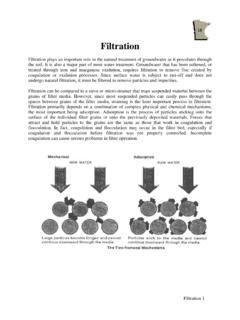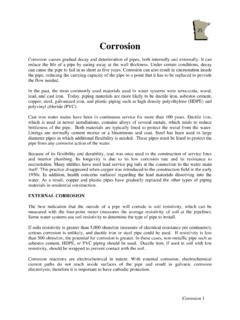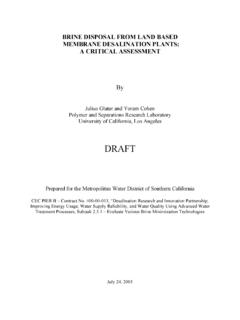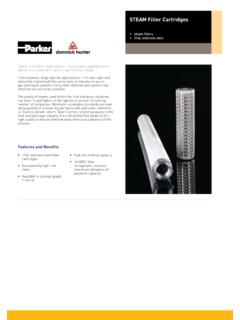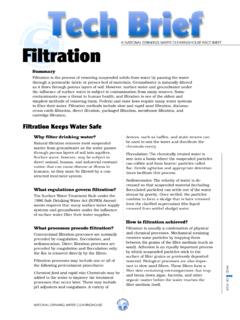Transcription of Membrane Filtration - MRWA
1 Membrane Filtration 1 Membrane Filtration A Membrane is a thin layer of semi-permeable material that separates substances when a driving force is applied across the Membrane . Membrane processes are increasingly used for removal of bacteria, microorganisms, particulates, and natural organic material, which can impart color, tastes, and odors to water and react with disinfectants to form disinfection byproducts. As advancements are made in Membrane production and module design, capital and operating costs continue to decline. The Membrane processes discussed here are microfiltration (MF), ultrafiltration (UF), nanofiltration (NF), and reverse osmosis (RO).
2 MICROFILTRATION Microfiltration is loosely defined as a Membrane separation process using membranes with a pore size of approximately to 10 micronas (1 micron = millimeter), a molecular weight cut-off (MWCO) of greater than 1000,000 daltons and a relatively low feed water operating pressure of approximately 100 to 400 kPa (15 to 60psi) Materials removed by MF include sand, silt, clays, Giardia lamblia and Crypotosporidium cysts, algae, and some bacterial species. MF is not an absolute barrier to viruses. However, when used in combination with disinfection, MF appears to control these microorganisms in water.
3 There is a growing emphasis on limiting the concentrations and number of chemicals that are applied during water treatment. By physically removing the pathogens, Membrane Filtration can significantly reduce chemical addition, such as chlorination. Another application for the technology is for removal of natural synthetic organic matter to reduce fouling potential. In its normal operation, MF removes little or no organic matter; however, when pretreatment is applied, increased removal of organic material can occur. MF can be used as a pretreatment to RO or NF to reduce fouling potential. Both RO and NF have been traditionally employed to desalt or remove hardness from groundwater.
4 ULTRAFILTRATION Ultrafiltration has a pore size of approximately to microns, an MWCO of approximately 10,000 to 100,000 daltons, and an operating pressure of approximately 200 to 700 kPa (30 to 100 psi). UF will remove all microbiological species removed by MF (partial removal of bacteria), as well as some viruses (but not an absolute barrier to viruses) and humic materials. Disinfection can provide a second barrier to contamination and is therefore recommended. The primary advantages of low-pressure UF Membrane processes are compared with conventional clarification and disinfection (post-chlorination) processes are: No need for chemicals (coagulants, flocculants, disinfectants, pH adjustment) Size-exclusion Filtration as opposed to media depth Filtration Membrane Filtration 2 Constant quality of the treated water in terms of particle and microbial removal Process and plant compactness Simple automation However, fouling can cause difficulties in Membrane technology for water treatment.
5 NANOFILTRATION Nanofiltration membranes have a nominal pore size of approximately microns and an MWCO of 1,000 to 100,000 daltons. Pushing water through these smaller Membrane pores requires a higher operation pressure than either MF or UF. Operating pressures are usually near 600 kPa (90psi) and can be as high as 1,000 kPa (150psi). These systems can remove virtually all cysts, bacteria, viruses, and humic materials. They provide excellent protection from DBP formation if the disinfectant residual is added after the Membrane Filtration step. Because NF membranes also remove alkalinity, the product water can be corrosive, and measures, such as blending raw water and product water or adding alkalinity, may be needed to reduce corrosivity.
6 NF also removes hardness from water, which accounts for NF membranes sometimes being called softening membranes. Hard water treated by NF will need pretreatment to avoid precipitation of hardness ions on the Membrane . However, more energy is required for NF than MF or UF. REVERSE OSMOSIS Reverse osmosis can effectively remove nearly all inorganic contaminants from water. RO can also effectively remove radium, natural organic substances, pesticides, cysts, bacteria and viruses. RO is particularly effective when used in series with multiple units. Disinfection is also recommended to ensure the safety of water. Some of the advantages of RO are: Removes nearly all contaminant ions and most dissolved non-ions, Relatively insensitive to flow and total dissolved solids (TDS level and suitable for small systems with a high degree of seasonal fluctuation in water demand, RO operates immediately, without any minimum break-in period, Low effluent concentration possible, Bacteria and particles are also removed, and Operational simplicity and automation allow for less operator attention and make RO suitable for small system applications.)
7 Some of the limitations of RO are: Membrane Filtration 3 High capital and operating costs, Managing the wastewater (brine solution) is a potential problem, High level of pretreatment is required in some cases, Membranes are prone to fouling and Produces the most wastewater at between 25-50 percent of the feed. Membrane MATERIALS Normally, Membrane material is manufactured from a synthetic polymer, although other forms, including ceramic and metallic membranes, may be available. Almost all membranes manufactured for drinking water are made of polymeric material, since they are significantly less expensive than membranes constructed of other materials.
8 Membranes constructed of polymers that react with oxidants used in drinking water treatment should not be used with chlorinated feed water. Mechanical strength is another consideration, since a Membrane with greater strength can withstand larger trans- Membrane pressure (TMP) levels, allowing for greater operational flexibility and the use of higher pressures. Membranes with bi-directional strength may allow cleaning operations or integrity testing to be performed from either feed or filtrate side of the Membrane . Membranes with a particular surface charge may remove particulate or microbial contaminants of the opposite charge due to Membrane Filtration 4 electrostatic attraction.
9 Membranes can also be hydrophilic (water attracting) or hydrophobic (water repelling). These terms describe how easily membranes can be wetted, as well as its ability to resist fouling to some degree. MF and UF membranes may be constructed from a wide variety of materials, including cellulose acetate, polyvinylidene fluoride, polyacrylonitrile, polypropylene, polysulfone, polyethersulfone, or other polymers. Each of these materials has different properties with respect to the surface charge, degree of hydrophobicity, pH and oxidant tolerance, strength and flexibility. NF and RO membranes are generally manufactured from cellulose acetate or ployamide materials, and their various advantages and disadvantages.
10 Cellulose membranes are susceptible to biodegradation and must be operated within a narrow, pH range of 4 to 8 but they do have some resistance to continuous low-level oxidants. Chlorine doses of mg/L or less may control biodegration and biological fouling without damaging the Membrane . Polyamide membranes, by contrast, can be used under a wide range of pH conditions and are not subject to biodegradation. Although these membranes have very limited tolerance for strong oxidants, they are compatible with weaker oxidants such as cholramines. These membranes require significantly less pressure to operate and have become the predominate material used for NF or RO applications.

